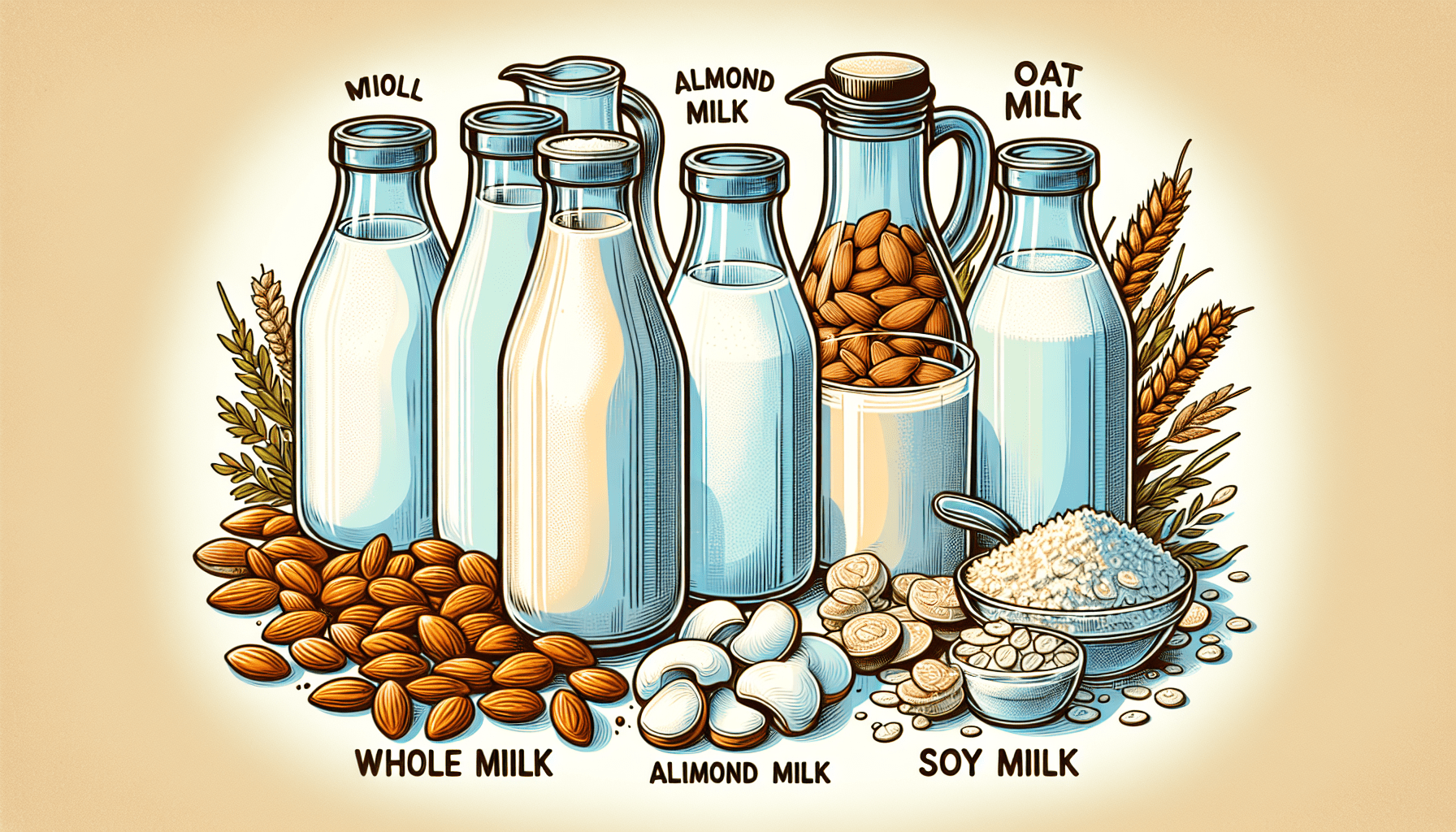If you’re a coffee lover who enjoys a frothy and creamy cappuccino or latte, you may be wondering if you can experiment with different types of milk in your super-automatic espresso machine. The answer is a resounding yes! Whether you prefer the richness of whole milk, the subtle sweetness of almond milk, or the creaminess of oat milk, you can certainly use different types of milk for frothing in your machine. In this article, we’ll explore the various options available and guide you on how to achieve the perfect froth for your preferred milk choice. So, grab your favorite mug and let’s get started on an exciting milk frothing adventure!
Different types of milk for frothing
When it comes to frothing milk, there are various options available to suit different preferences and dietary needs. Whether you’re a coffee connoisseur or simply enjoy a frothy cappuccino or latte, understanding the different types of milk that can be used for frothing is essential. In this article, we will explore the three main categories of milk for frothing: cow’s milk, plant-based milk, and non-dairy creamers. We will discuss the various options within each category, as well as important considerations such as fat content, protein content, sugar content, and foaming properties. So, let’s dive right in and discover the world of froth-worthy milk options!
Cow’s milk
Cow’s milk is the most commonly used milk for frothing due to its natural foaming properties. It is available in different variations, each with its own unique characteristics. Let’s take a look at the different types of cow’s milk commonly used for frothing:
Whole milk
Whole milk is the richest and creamiest option for frothing. It has a higher fat content than other types of milk, which contributes to its luxurious texture and velvety foam. If you prefer a rich and indulgent beverage, whole milk is an excellent choice.
2% reduced-fat milk
For those who want a balance between richness and lower fat content, 2% reduced-fat milk is a good option. It still provides a creamy texture and decent foam, but with less fat than whole milk. If you’re conscious about your calorie intake but still want a frothy delight, 2% reduced-fat milk is a great compromise.
Skim milk
Skim milk, also known as fat-free or non-fat milk, is the leanest option for frothing. With almost no fat, it produces a less creamy texture and thinner foam compared to whole milk or reduced-fat milk. If you’re aiming for a lighter frothed milk experience, skim milk could be a suitable choice.
Plant-based milk
With the rise in popularity of plant-based diets and dietary restrictions, plant-based milk has gained significant traction as an alternative to cow’s milk for frothing. There are a variety of plant-based milk options available, each with its own unique characteristics. Let’s explore some of the most common plant-based milk choices for frothing:
Soy milk
Soy milk is the most well-known and widely available plant-based milk option. It has a naturally creamier texture and slightly nutty flavor, making it a popular choice for frothing. Soy milk typically produces a decent foam, although it may not be as velvety and stable as cow’s milk.
Almond milk
Almond milk has a slightly nutty taste and a thinner consistency compared to cow’s milk. While it may not produce as much foam as cow’s milk, it can still create a light and airy texture. However, it’s important to note that almond milk can sometimes separate when heated, so finding a suitable brand for frothing is crucial.
Oat milk
Oat milk has gained popularity for its creamy consistency and slightly sweet taste. It froths well, producing a thick and stable foam that closely resembles the texture of cow’s milk. Oat milk is a versatile option suitable for various hot beverages, making it a favorite among baristas and coffee enthusiasts alike.
Coconut milk
Coconut milk offers a unique tropical flavor profile to frothed beverages. It has a rich and creamy texture, aiding in the creation of velvety foam. However, coconut milk can sometimes be too heavy and overpowering for some delicate coffee flavors. It’s best to experiment with different ratios to achieve a balance that suits your taste preferences.
Rice milk
Rice milk has a naturally sweet taste and a thinner consistency compared to cow’s milk. While it may not produce as much foam as other types of milk, it can still add a subtle frothy texture to your favorite hot beverages. Rice milk is particularly suitable for those with allergies or dietary restrictions as it is free from common allergens.
Non-dairy creamers
Non-dairy creamers are alternative options to traditional milk for frothing. They are usually made with a combination of oils, thickeners, and sweeteners to mimic the taste and texture of milk. Let’s explore the two main types of non-dairy creamers:
Powdered creamers
Powdered creamers are popular for their convenient storage and long shelf life. They mix easily with hot beverages and can produce a decent foam when frothed. However, they often contain a higher amount of artificial ingredients and lack the natural flavor and creaminess of milk or plant-based alternatives.
Liquid creamers
Liquid creamers are another option for those who prefer a non-dairy alternative for frothing. They come in various flavors and can provide a creamy texture to your hot beverages. While they may not foam as well as real milk, they offer a convenient and versatile solution for frothed drinks.
Considerations for frothing milk
When choosing the right type of milk for frothing, several factors need to be considered. Let’s take a closer look at these considerations to help you make an informed decision for your frothing endeavors:
Fat content
The fat content of milk plays a significant role in the texture and foam produced when frothing. Higher fat milk, such as whole milk, tends to create a creamier and more stable foam, while lower fat milk, like skim milk, may result in a lighter and less stable foam. Non-dairy creamers, on the other hand, rely on alternative sources of fat to provide a creamy texture.
Protein content
Protein is another crucial element in milk that contributes to the frothing process. Proteins in milk help create structure in the foam, leading to a more stable and long-lasting texture. Cow’s milk generally has a higher protein content compared to plant-based milk, which can affect the frothing results. Some brands offer protein-fortified plant-based milk for better frothing performance.
Sugar content
The sugar content in milk can also impact the frothing process. Sweetened milk, whether natural or added sugars, can interfere with the foam structure and stability. Unsweetened milk is generally preferred for frothing, as it allows for better control of the foam consistency and sweetness of the final beverage. However, personal taste preferences should be taken into consideration when choosing sweetened or unsweetened milk.
Foaming properties
Different types of milk, both cow’s milk and plant-based milk, have varying foaming properties. Some milk varieties naturally froth better than others, providing a more desirable texture and density to the foam. It’s important to experiment and find the milk that best suits your frothing needs and personal preferences.
Experimenting with different milk types
Finding the perfect milk for frothing is often a matter of personal taste and experimentation. Here are a few factors to consider when experimenting with different milk types:
Taste preferences
Different milk varieties offer unique flavors that can enhance or complement your favorite hot beverages. Experiment with different types of milk to find the flavors that best suit your taste buds and complement the coffee or tea you’re pairing them with.
Allergies or dietary restrictions
For those with allergies or dietary restrictions, plant-based milk or non-dairy creamers can be a game-changer. They provide a suitable alternative to cow’s milk while still offering a frothy and enjoyable experience. Be sure to check ingredient labels for any potential allergens and choose options that meet your dietary needs.
Availability and cost
The availability and cost of different milk varieties may vary depending on your location and personal budget. Some plant-based milk may be more readily available in certain areas, while others may be more expensive. Consider the availability and cost of different milk options to find the ones that best fit your requirements.
In conclusion, frothing milk is a delightful way to enhance your favorite hot beverages, whether you’re using a super-automatic espresso machine or any frother. Understanding the different types of milk available for frothing, including cow’s milk, plant-based milk, and non-dairy creamers, allows you to choose the option that suits your preferences and dietary needs. Consider factors such as fat content, protein content, sugar content, and foaming properties when making your selection. Remember to experiment with different milk types to find the perfect frothy delight that meets your taste preferences, allergies or dietary restrictions, and budget. So go ahead, froth away, and enjoy your personalized frothy creations!



